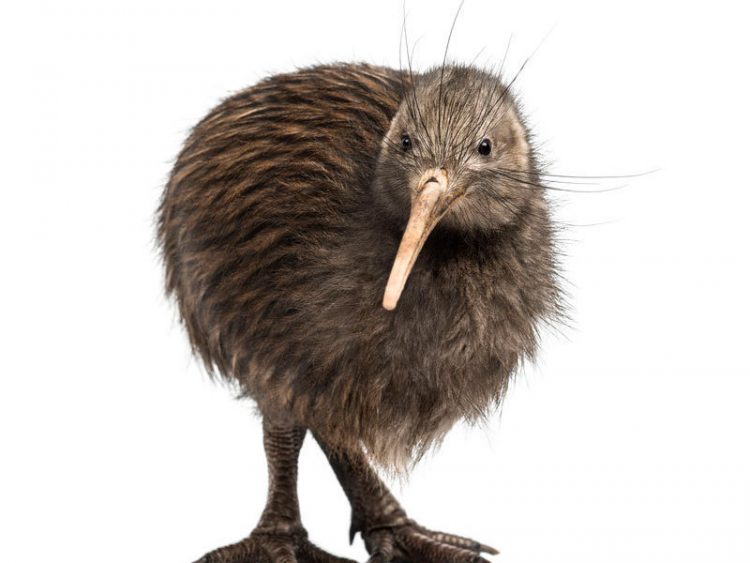Kiwi bird genome sequenced

Like all kiwi species, the Brown Kiwi (Apteryx mantelli) is adapted to living in darkness. The birds spend all day in a cave which they only leave at nightfall. In their nocturnal forays, they rely on smells and sounds - an unusual behaviour for birds. © 123RF/Eric Isselee
Its unusual biological characteristics make the flightless kiwi a unique kind of bird. Researchers of the University of Leipzig and the Max Planck Institute for Evolutionary Anthropology in Leipzig, Germany, have now sequenced the genetic code of this endangered species and have identified several sequence changes that underlie the kiwi’s adaptation to a nocturnal lifestyle:
They found several genes involved in colour vision to be inactivated and the diversity of odorant receptors to be higher than in other birds – suggesting an increased reliance on their sense of smell rather than vision for foraging. The study was published in the journal “Genome Biology”.
Kiwi have a number of features that make them interesting for study: They only have rudimentary wings, no tail and a very long beak with nostrils. They are mainly nocturnal with a low basal metabolic rate and the lowest body temperature among birds. To date there has been little genetic information available for this species that might help scientists to understand their unusual biology better.
An international team led by Torsten Schöneberg of the Institute of Biochemistry of the Medical Faculty at the University of Leipzig and Janet Kelso of the Max Planck Institute for Evolutionary Anthropology have now sequenced the genome of the brown kiwi (Apteryx mantelli).
Their analyses show genetic changes that likely reflect adaptation to nocturnal life. Although mutations have inactivated some of the key genes involved in colour vision, the number of odorant receptor genes is expanded suggesting that the kiwi sense of smell is highly developed. These changes happened about 35 million years ago which is after the kiwi’s arrival in New Zealand.
“Already French botanist and zoologist Jean Baptiste de Lamarck, who lived in the 18th century, hypothesized that evolution works in accordance with a ‘use it or lose it’ principle. It is therefore very likely that the kiwi lost its colour vision since this was no longer needed for its new nocturnal lifestyle”, says first author Diana Le Duc, MD, at the University of Leipzig. “The kiwi’s sense of smell – which was required for foraging in the dark of the night – became more acute and the repertoire of odorant receptors increased adapting to a wider diversity of smells.”
DNA analyses of two kiwi individuals show, however, that according to first estimates there is little genetic variability in the population. This could further endanger the survival of this species and will have to be taken into account when planning future breeding programs. “The genome of the kiwi is an important resource for future comparative analyses with other extinct and living flightless birds”, says computational biologist Janet Kelso of the Max Planck Institute for Evolutionary Anthropology.
The kiwi is the national symbol of New Zealand and belongs to a group of birds called ratites that also includes the extinguished New Zealand moa as well as flightless birds like ostrich, emu and rhea. Following human migration to New Zealand around 800 years ago, many of the local bird species became extinct. Despite intensive protection efforts the kiwi is highly endangered.
Contact
Dr. Diana LeDuc
Institute of Biochemistry, Medical Faculty
Universität Leipzig
Phone: +49 341 3550-544
Email: diana_leduc@eva.mpg.de
Prof. Dr. Torsten Schöneberg
Institute of Biochemistry, Medical Faculty
University of Leipzig
Phone: +49 341 9722-150
Email: torsten.schoeneberg@medizin.uni-leipzig.de
Janet Kelso
Max Planck Institute for Evolutionary Anthropology, Leipzig
Phone: +49 341 3550-552
Email: kelso@eva.mpg.de
Sandra Jacob
Press and Public Relations
Max Planck Institute for Evolutionary Anthropology, Leipzig
Phone: +49 341 3550-122
Fax: +49 341 3550-119
Email: info@eva.mpg.de
Original publication
Le Duc D., Renaud G., Krishnan A., Sällman Almén M., Huynen L., Prohaska S.J., Ongyerth M., Bitarello B.D., Schiöth H.B., Hofreiter M., Stadler P.F., Prüfer K., Lambert D., Kelso J., Schöneberg T.
Kiwi genome provides insights into evolution of a nocturnal lifestyle
Genome Biology, 23 July 2015 (doi: 10.1186/s13059-015-0711-4)
Media Contact
All latest news from the category: Life Sciences and Chemistry
Articles and reports from the Life Sciences and chemistry area deal with applied and basic research into modern biology, chemistry and human medicine.
Valuable information can be found on a range of life sciences fields including bacteriology, biochemistry, bionics, bioinformatics, biophysics, biotechnology, genetics, geobotany, human biology, marine biology, microbiology, molecular biology, cellular biology, zoology, bioinorganic chemistry, microchemistry and environmental chemistry.
Newest articles

Properties of new materials for microchips
… can now be measured well. Reseachers of Delft University of Technology demonstrated measuring performance properties of ultrathin silicon membranes. Making ever smaller and more powerful chips requires new ultrathin…

Floating solar’s potential
… to support sustainable development by addressing climate, water, and energy goals holistically. A new study published this week in Nature Energy raises the potential for floating solar photovoltaics (FPV)…

Skyrmions move at record speeds
… a step towards the computing of the future. An international research team led by scientists from the CNRS1 has discovered that the magnetic nanobubbles2 known as skyrmions can be…





















